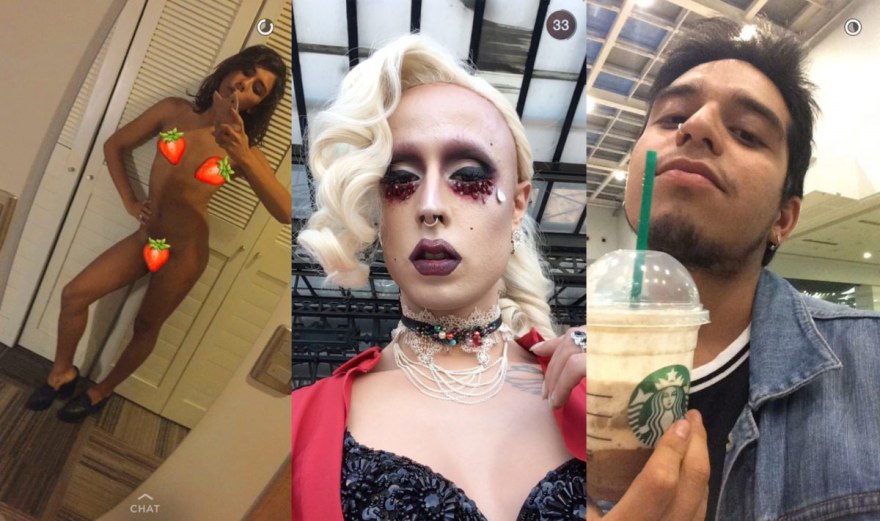Tea time with Snap
An interview with Felipe Elgueta and Ananké Pereira, directors of Snap
Why did you set your film on Snapchat and its “stories”?
We started working with Snap for two reasons. The first one is that when we discovered the application, we became obsessed with all the material people uploaded and without being very sure about what we could do with it, we felt the need to tell a story with this material. The second reason is that it aligned with discussions and work we had been doing on how the Internet and virtual life can be transferred to cinematographic language.
Were you interested in drawing a parallel with a diary? In your opinion, what are we searching for when we publish that diary on Snapchat instead of keeping it secret?
More than making a parallel with a diary, we wanted to explore the way people build and represent themselves through the social media. This format allowed us an extraordinary access to people’s private lives and also to discover a language which was becoming popular.
We think that people try to create a character of themselves through their stories, we see what they are trying to tell about themselves through the material they upload. To expose themselves, to express themselves – some of them in a more intentional way than others.
Instagram and Facebook recently added a Snapchat-like insert, do you think this form of electronic communication will grow? And evolve?
Of course, when we started working on the short film, Instagram did not have the stories yet, so this type of communication was mainly within a teenage range. However, the appropriation of the format on the part of other media made it available to more people; it became massive and official as a valid means of communication. It’s very impressive to see how people are instinctively developing this audiovisual micro language in order to show their lives, and how all consumers become part of the game. We love it.
Why did you pick that story and no other?
During the period of research, we recorded more than forty Snapchat users, many of them were very interesting, however people tend to show certain types of moments, and so they become repetitive. Therefore, we started approaching those characters we felt gave us greater access to their lives. After that, we discussed the material we had and we chose those which seemed to us to have a better dialogue about self-shooting, the body, and the gender.
Did the main character know that you were recording everything? From the beginning?
None of them knew they were being recorded. The process of finding a story and understanding how to tell it was long and very intimate. When we were sure about what we wanted to say, we contacted the characters to tell them about our project. We knew that the first time we met would be risky but they were all happy to take part and to know that the material they thought had disappeared still existed.
Snap shows scenes of public lynching, how do you explain this violence? Is it punished or protected by the law?
Lately, in Chile, the problem of criminality has been used as a political weapon in election campaigns. For this reason, much of people’s frustration is directed towards pickpockets, mobile phone snatchers, etc. These “detentions by citizens” have happened all over the country and they are registered on YouTube. Citizens discover thieves and they detain them, unfortunately, this awakens, in general, the level of violence that people carry inside themselves and detentions often end up in disproportionate beatings and humiliation. They are not permitted by the law but there is no punishment, either. This is due to the fact that if you are a criminal, you are immediately devoid of your rights, according to people.
How long did the accumulation of snaps last and did you have a lot of rushes to edit?
We recorded each of the forty characters we followed every day for a year. It was a lot of material but we started with the editing about five months after we started the recording. The research and editing methodology made the process less tiring, though it was a long one.
What sort of freedom would you say the short format allows?
We felt very free at the time of working with the material but this same freedom made it more difficult. The format was new, of short duration, with different shooting qualities, and with a variety of topics. Mainly, I think we could have played more, at the moment of editing, with the stories’ time, order, rhythm, and that we could have also added other Internet material, not coming from Snapchat, necessarily.
If you’ve already been to Clermont-Ferrand, could you share with us an anecdote or story from the festival? If not, what are your expectations for this year?
We find it very entertaining to participate in the lab category, to be able to meet the 24 projects that participate and discuss the cinematographic language that each short film proposes. On the other hand, we are interested in receiving feedback about Snap, what makes sense to them and that does not, in a context like this.
Snap is being shown in Lab Competition L4.








